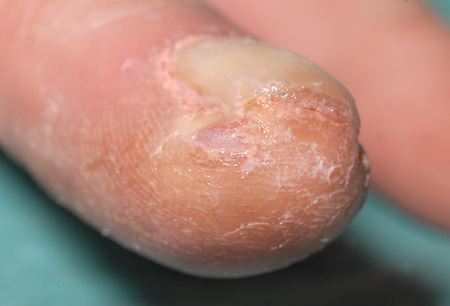Summary
Definition
História e exame físico
Principais fatores diagnósticos
- presença de fatores de risco
Outros fatores diagnósticos
- parestesias/sensação de frio/cianose no membro ou dedo
- ulceração/gangrena
- claudicação
- dor em repouso
- tromboflebite superficial
- membro ou dedo frio
- membro ou dedo pálido
- ausência de pulsos distais
- teste de Allen positivo
- artrite
- duração de até 2 semanas dos sintomas articulares
Fatores de risco
- tabagismo
- idade <40 anos
- região de origem: sudeste do Mediterrâneo, Oriente Médio e Extremo Oriente
- sexo masculino
- infecção periodontal
- haplótipos do antígeno leucocitário humano (HLA)
Investigações diagnósticas
Primeiras investigações a serem solicitadas
- glicose sanguínea
- ureia
- creatinina sérica
- hemograma completo com diferencial
- coagulograma
- rastreamento para trombofilia
- proteína C-reativa
- velocidade de hemossedimentação (VHS)
- Doppler arterial
Investigações a serem consideradas
- anticorpo antinuclear
- fator reumatoide
- anticorpo anticitoplasma de neutrófilo (ANCA)
- níveis do complemento
- anticorpo anticentrômero
- anticorpos antitopoisomerase I (Scl-70)
- ecocardiograma
- duplex arterial
- angiografia digital por subtração
- anticorpos anticardiolipina
Novos exames
- Angiotomografia
- angiografia por ressonância magnética
- biópsia tecidual
- teste genético
Algoritmo de tratamento
isquemia crítica
isquemia não crítica
Colaboradores
Autores
Matthew J. Metcalfe, MD, FRCS, FEBVS, FHEA

Consultant Vascular Surgeon
Lister Hospital
East and North Hertfordshire NHS Trust
Hertfordshire
UK
Declarações
MJM declares that he has no competing interests.
Alun H. Davies, MA, DM, FRCS, FHEA

Professor of Vascular Surgery and Honorary Consultant Surgeon
Department of Vascular Surgery
Faculty of Medicine
Imperial College of Medicine
Charing Cross Hospital
London
UK
Declarações
AHD declares that he has no competing interests.
Revisores
Kosmas I. Paraskevas, MD, FASA
Department of Vascular Surgery
Red Cross Hospital
Athens
Greece
Declarações
KIP declares that he has no competing interests.
Maureen K. Sheehan, MD
Assistant Professor of Surgery
Division of Vascular Surgery
University of Texas Health Science Center at San Antonio
San Antonio
TX
Declarações
MKS declares that she has no competing interests.
Peter F. Lawrence, MD
Chief of Vascular Surgery
Director
Gonda Vascular Center
David Geffen School of Medicine at UCLA
Los Angeles
CA
Declarações
PFL declares that he has no competing interests.
Créditos aos pareceristas
Os tópicos do BMJ Best Practice são constantemente atualizados, seguindo os desenvolvimentos das evidências e das diretrizes. Os pareceristas aqui listados revisaram o conteúdo pelo menos uma vez durante a história do tópico.
Declarações
As afiliações e declarações dos pareceristas referem--se ao momento da revisão.
Referências
Principais artigos
Lie JT. The rise and fall and resurgence of thromboangiitis obliterans (Buerger's disease). Acta Pathol Jpn. 1989 Mar;39(3):153-8. Resumo
Olin JW, Young JR, Graor RA, et al. The changing clinical spectrum of thromboangiitis obliterans (Buerger's disease). Circulation. 1990 Nov;82(5 suppl):IV3-8. Resumo
Buerger L. Thrombo-angiitis obliterans: a study of the vascular lesions leading to presenile spontaneous gangrene. Am J Med Sci. 1908 Nov;136(5):567-80.
Papa MZ, Rabi I, Adar R. A point scoring system for the clinical diagnosis of Buerger's disease. Eur J Vasc Endovasc Surg. 1996 Apr;11(3):335-9. Resumo
Ohta T, Ishioashi H, Hosaka M, et al. Clinical and social consequences of Buerger disease. J Vasc Surg. 2004 Jan;39(1):176-80. Resumo
Cacione DG, Macedo CR, do Carmo Novaes F, et al. Pharmacological treatment for Buerger's disease. Cochrane Database Syst Rev. 2020 May 4;5:CD011033.Texto completo Resumo
Artigos de referência
Uma lista completa das fontes referenciadas neste tópico está disponível para os usuários com acesso total ao BMJ Best Practice.

Differentials
- Doença embólica
- Estado hipercoagulável
- fenômeno de Raynaud (FR)
Mais DifferentialsPatient information
Abandono do hábito de fumar
Fenômeno de Raynaud
More Patient informationLog in or subscribe to access all of BMJ Best Practice
Use of this content is subject to our disclaimer